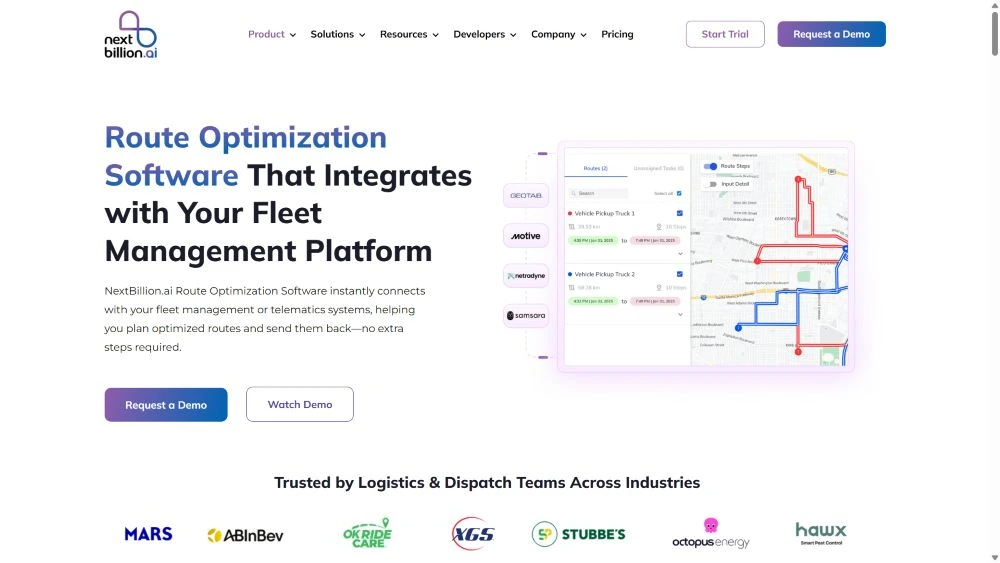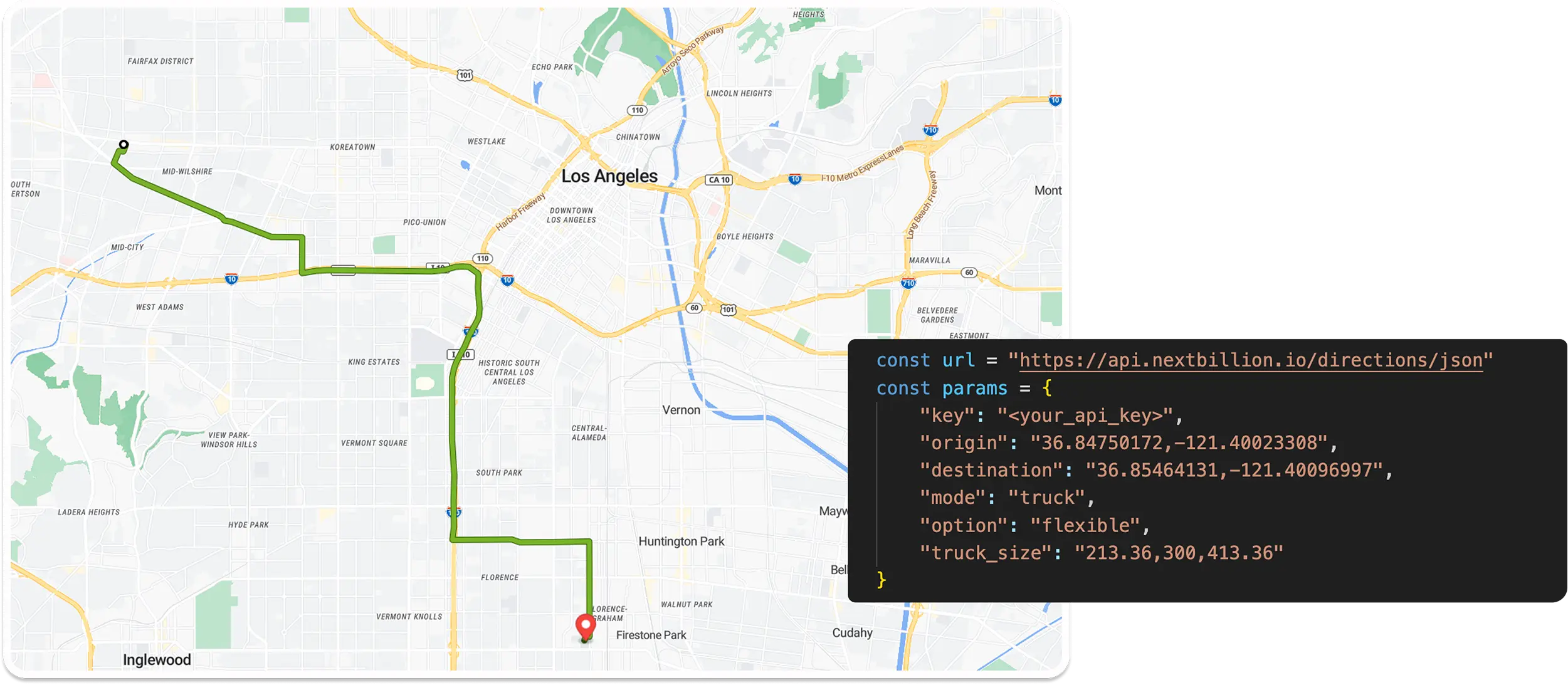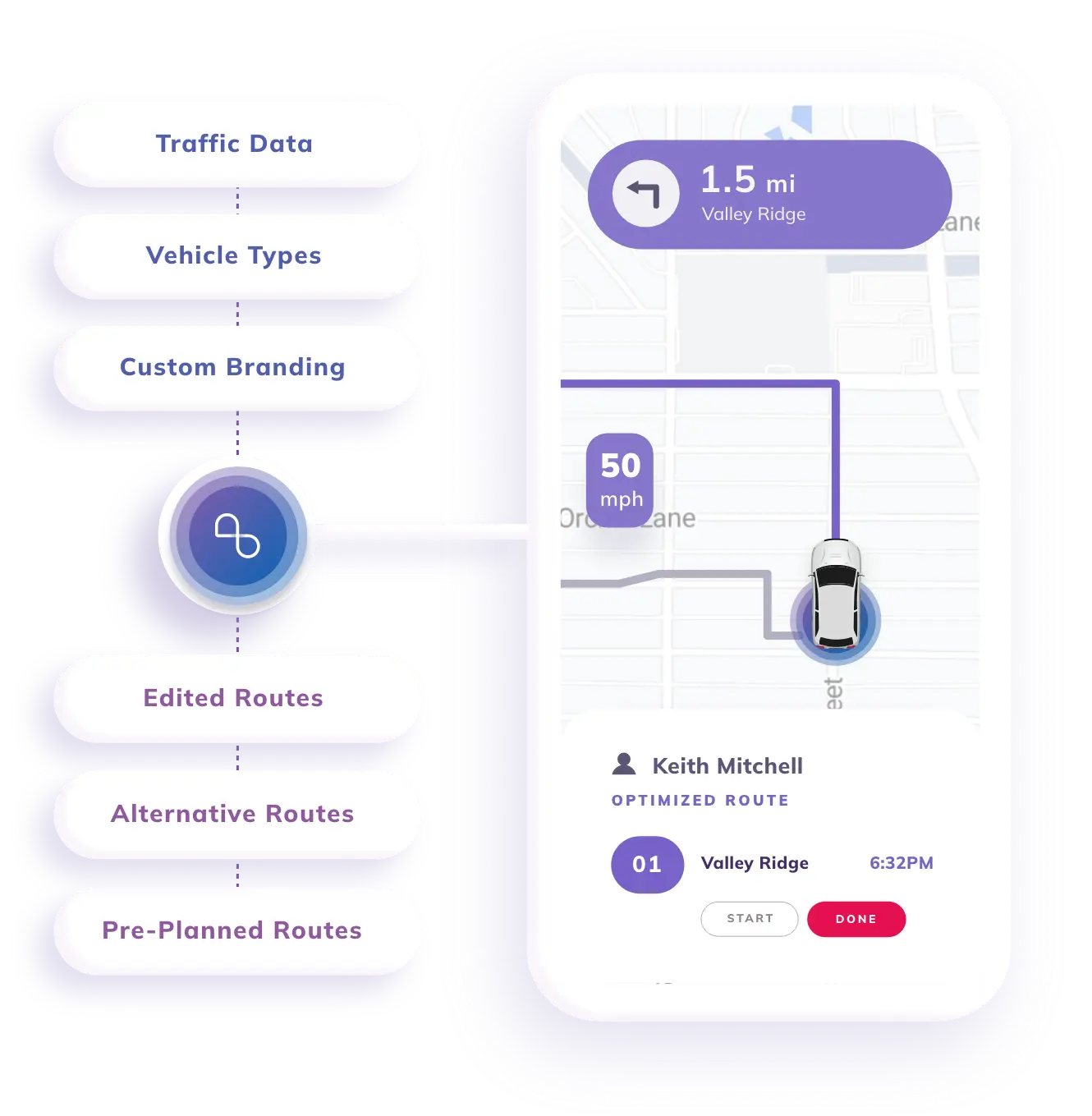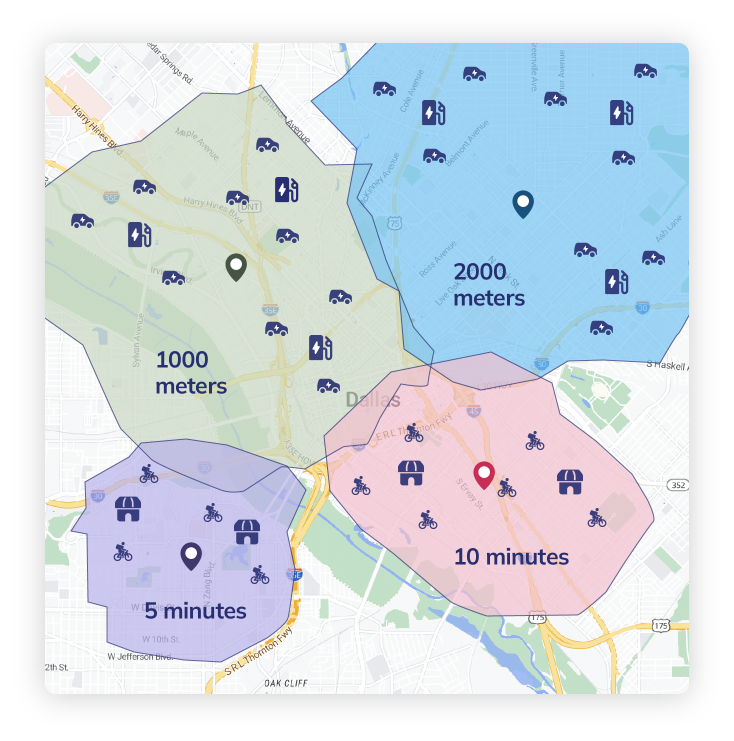

- BLOG
Reducing Route Deviations in Complex Markets with Custom APIs
Published: October 24, 2025
Route Optimization API
Optimize routing, task allocation and dispatch
Distance Matrix API
Calculate accurate ETAs, distances and directions
Directions API
Compute routes between two locations
Driver Assignment API
Assign the best driver for every order
Routing & Dispatch App
Plan optimized routes with 50+ Constraints
Product Demos
See NextBillion.ai APIs & SDKs In action
AI Route Optimization
Learns from Your Fleet’s Past Performance
Platform Overview
Learn about how Nextbillion.ai's platform is designed
Road Editor App
Private Routing Preferences For Custom Routing
On-Premise Deployments
Take Full Control of Your Maps and Routing
Trucking
Get regulation-compliant truck routes
Fleet Management
Solve fleet tracking, routing and navigation
Middle Mile Delivery
Optimized supply chain routes
Construction
Routes for Construction Material Delivery
Oil & Gas
Safe & Compliant Routing
Food & Beverage
Plan deliveries of refrigerated goods with regular shipments
Table of Contents

Have you ever wondered how your drivers can still fail to meet delivery windows or take the wrong path, even when everything was planned out in detail? Traditional route planning does not always work in dynamic markets, which are complex. Even the best-thought logistics plan may go off track due to some of these factors, such as sudden traffic jams, construction, weather disruptions, and sudden stops.
It is not only the deviation itself that is a problem. It is the expense, time wastage, customer dissatisfaction, and inefficiencies in operations that come later. However, using the appropriate technology, these problems can be avoided. Flexible, intelligent routing systems that react and adapt to real-time conditions and keep the deliveries on time can now be created by custom APIs, involving the logistics teams.
Continue to read about how to minimize route deviations, enhance fleet performance, and gain total control of your logistics activities with the strength of smart APIs.

In logistic networks where time and efficiency are not negotiable, it is important to find out what causes a deviation in the route so as to rectify the situation. The most prevalent causes that interfere with the delivery paths and undermine fleet optimization and supply chain transparency are listed below.
Traffic jams, road blocks, and construction areas can simply nullify a planned route. When route planning is based only on the use of the stagnant maps or the old schedules, the drivers must make last minute decisions, which tend to result in inefficient detours. This is where real-time traffic routing comes in. Detours can be prevented by sending live congestion information into your logistics control tower with custom APIs.
Traffic defections are also commonly caused by:
Weather does not only postpone flights, as it also interferes with ground logistics. The highways being covered with snow, roads filled with water, visibility impaired by fog can transform a route that seemed to be the best one to the unstable one. Here most routing engines fail to work since they do not take into consideration live weather inputs. Embarking on weather-conscious dynamic routing APIs will enable the dispatcher to adjust routes dynamically in order to be safe and effective.
Weather-related disturbances that are normally caused by weather and result in deviations:
The most sophisticated routing system is still susceptible to the influence of manual decisions. Drivers can avoid stops, rearrange deliveries to be convenient, or misunderstand instructions. These sequence violations introduce some unpredictability in your operation and make fleet optimization difficult. The driver compliance can be monitored and fixed in seconds with such tools as Snap to Roads API and Geofence API.
Some behavior-driven deviations have the following examples:
Old-fashioned GPSs or low-quality navigation applications do not fit well in dense, rapidly dynamic areas. Signal loss, out-of-date maps, or failure to update in real-time may lead to deviation of the route that is not noticed. When customized to complex marketplaces, modern route optimization APIs deliver current and hyperlocal route logic that ensures the alignment of drivers.
Such problems with navigation that violate route drift include:
Plans in a fast moving supply chain are usually modified dynamically. New orders arrive, stops are canceled, and delivery schedules are changed. When these changes fail to keep up with the routing system of the driver in real time, it results in confusion and inefficient detours. By incorporating its own API in your route planning engine, dynamic updates can be flowing effectively to on-ground drivers.
Last-minute changes that cripple scheduled routes include:
There is also an additional layer of complexity that is compliance and safety issues in specific geographies. Unplanned route changes can be as a result of unexpected security checks, high risk zones, or restricted areas. The inclusion of zone-based rules into routing using geofencing APIs assists in rerouting around risk zones in advance and still ensures compliance with the routes.
Deviation triggers such as security and compliance are:
Not all deviations are accidental. Sometimes drivers intentionally choose what they perceive to be a faster, easier, or safer route, even if it violates the optimized plan. These decisions may reduce short-term driving stress but often increase long-term inefficiencies, higher costs, and SLA violations. With real-time monitoring APIs and geofencing, managers can detect and address these deviations instantly.
Intentional deviation scenarios include:
Unplanned road closures or prolonged construction activities can instantly invalidate even the most carefully optimized route. Unlike temporary congestion, a closure often forces a complete detour that increases mileage and delivery time. Static maps or outdated GPS systems may not reflect closures quickly enough, leading to driver confusion and additional deviations. Integrating real-time traffic routing APIs ensures closures are detected early and dynamic rerouting is communicated instantly to the driver.
Frequent causes of route deviations from closures include:
A couple of miles of rerouting or a slight diversion may seem small in its own right. However, when the logistics ecosystem faces route diversion, the ripple effect is extensive. Even minor variations in a market that requires speed, accuracy, and reliability are multiplied into quantifiable operation losses. These interferences add to the costs, underutilizing the assets, and its fleets, and supply chain visibility in general.
Let us deconstruct the impacts of the various forms of deviations, both the path deviations and sequence violations, on the transport costs and delivery schedules:
Unintended traffic jams create increased routes and even more engine operation durations, which causes increased fuel consumption. This may eventually not only go up on the fuel costs but also on the wear and tear of a vehicle, such as the tires, the oil used, and a strained brake system. This amounts to high operating costs in fleets that run at a large scale.
Key impacts include:
By including a route optimization API which helps to determine efficient, real-world delivery routes, unnecessary mileage is minimized and budgets on fuel are controlled.
Delivery windows suffer a lot when vehicles do not follow their predetermined sequence or route. This is especially essential with time-sensitive shipments like perishables, pharmaceuticals, or just-in-time shipments in the retail sector. Failure to fulfil service-level agreements (SLAs) does not only frustrate the customers but may lead to the financial fines and contract abandonment.
Deviations contribute to:
Delays can be reduced by using dynamic routing APIs where the routes are updated dynamically as traffic and operational conditions change to ensure time promises are met.
The increased routes and delivery times directly influence the hours of the drivers and, more frequently, shift them to the overtime. This does not only raise the cost of labor but it can also be a breach of the compliance to labor law or internal workforce planning models. Exhaustion related to the long-distance driving also influences the safety and judgment in the road.
Some of the challenges related to labor are:
The fleet optimization system, through the support of its own APIs, can track the tendencies of deviation and assist dispatchers to redistribute the workload smartly.
Deviations on routes harm the effectiveness of whole delivery loops. One late vehicle at one stop derails the timing of other stops, resulting in consecutive inefficiencies. This decreases the count of successful deliveries per shift over time, decreases the vehicle use, and messes up the coordination of the logistics hubs.
Deviations lead to operational inefficiencies, which are:
Performance tracking can be automated by custom logistics APIs, and mid-shift route recalibration can be implemented to increase throughput.
Customers are now in the competitive delivery environment and demand updates, punctuality, and reliability. Customer experience is negatively affected when routes are misleading or slow to meet their schedule. Recurring failures can lead to termination of the contract, bad reviews, or fines as per performance-based contract.
Impacts on the customer experience will include:
Recording and analyzing the route execution with the help of a route report API also contributes to keeping accountability and facilitates proactive communication with customers.
Once routes are often not following the plan, then it is more difficult to optimize the operations of logistics managers and planners themselves. The accuracy of machine learning models, which have been trained using historical data, is lower, and routing decisions are less accurate. Such unpredictability prompts the planning of buffers, and it swells resource allocation and damages margins.
The issues that are caused by deviations are:
The combination of custom APIs and route analytics together with ERP systems aids in defining patterns and automating exception handling.
Having analyzed the reasons behind the route deviation, which can be the traffic, weather conditions, behaviour of the drivers, or operating changes, one can conclude that inefficient route planning in the beginning is a major issue. The majority of these deviations occur due to the failure of the planned routes to consider the real-time considerations like traffic jam, road closures, or last-minute changes.
This is where custom APIs would be applicable. With the introduction of route planning and management APIs into your current system, your operations will be much more dynamic, intelligent, and efficient.
Routes plans that fail to take into consideration live traffic information are very susceptible to disturbance. Custom APIs are able to combine real-time feeds of traffic databases, public road infrastructure, and other private data sources with your routing engine. This allows the system to realize congestion, accidents, or road closures in real time and suggest a more effective alternative.
Instead of human drivers manually calculating detour decisions, it is automatically recalculated and sent to the navigation system of the vehicle. This automation significantly helps to minimize the possibility of path deviations due to traffic surprises, particularly in cities with high-traffic-density delivery systems or new markets with dynamic road conditions.
A sequence violation happens frequently when the stop orders are not optimized based on the real-world delivery requirements like time window, service times, or customer importance. A route optimization API is able to compute the most efficient path of stops and does not go back and forth due to every route being aware of the delivery schedules, and they are mined based on parameters that continuously change.
This saves fuel, time, and makes deliveries consistent as well. Stop sequences can be re-optimized dynamically during the shift, even when products are canceled or new pickup orders are received, by feeding this logic to the routing system of the fleet.
Timely information is necessary, but history provides an extra dose of intelligence. Predictive route planning APIs take metrics of past journeys, like a slowdown of traffic, seasonal traffic jams, or typical construction areas, to forecast disruptions that might happen later on their routes. All these insights are applied in advance in influencing the routing decisions before the vehicle gets on the road.
This predictive reason is especially strong in complicated logistics networks where planned and real route differences are frequent. It makes routing preventive instead of reactive, and minimizes variability and enhances schedule reliability in the long run.
The actual power of custom APIs is the fact that they are interoperable. They do not substitute your GPS, TMS, ERP, or even fleet management system, but they expand them. APIs are able to extract information out of order management systems, refine driver instructions in real time, and provide easy centralized visibility to operations teams. They provide a smooth flow of communication between the planning, dispatch, navigation, and tracking functions when linked to your logistics control tower.
This removes data silos, and any change of route: be it traffic, weather, or customer request is immediately available across all systems, eliminating lag, confusion, and manual coordination. Consequently, teams are able to have a closer management of the network and can correct deviation before it turns into a costly mistake.
Here’s a breakdown of the essential APIs that logistics operators can integrate to build more intelligent, reliable, and deviation-resistant routing systems.

The Route Optimization API serves as the foundation of intelligent routing. It calculates the most efficient multi-stop routes by considering time windows, delivery priorities, service durations, and real-time distance metrics.
For delivery fleets operating in congested urban zones or across sprawling rural networks, this API ensures that stop sequences are optimized to minimize distance and service time, directly reducing both path deviations and sequence violations.

The Directions API provides drivers with turn-by-turn driving directions with a high degree of accuracy that allows real-world navigation to be in line with the optimized plan. This API plays a very important role in reducing errors in navigation, like missing turns, incorrect exits, or inefficient detours. It does this by taking real-time road data and updating the route constantly, so it makes sure that there is a match between the digital plan and the driver execution. Directions API is used in congested urban markets or when the delivery area is unfamiliar and is used to keep the route compliant and lower the cognitive burden on the driver.
The Distance Matrix API enables the systems to determine travel times and travel distances between two or more origin-destination pairs in real time. The API is crucial in route generation and the sequencing of stops because it determines the quickest or shortest path among multiple locations. It improves the performance of the Route Optimization API because it provides precise travel estimates in areas where conditions are varying by the day. This API is important when it comes to making deliveries in variable service zones or during times of peak traffic congestion to ensure that the deliveries are realistic and reachable.
Poor connection of GPS signals, particularly in canyons of the cities or distant locations, may lead to ineffective route tracking as well as misleading deviation notifications. This is resolved by the Snap to Roads API, which snaps raw GPS coordinates to the closest road segments in the real world. This is essential to back-office systems that are based on playback of historical routes, live monitoring, or performance audits. It guarantees that the adherence to the route is gauged with high accuracy, and therefore, the noise in the deviation reporting is reduced and actionable analytics can be observed in the logistics control towers.
The Route Report API provides an account of the real route operation, such as the distance traveled, the number of stops, time elapsed, and any deviation that a route follows. Such reporting is critical in determining the difference between plan and implementation, future route optimization, and delivery accuracy assurance to the customers. With the inclusion of this API, logistics teams can have insight into driver behavior, delivery compliance, and on-ground constraints, which could not have been clear at the time of planning.

Navigation API is an extension of the concept of the static routing system, which is dynamic and real-time, and which recommends directions to drivers depending on the current road and traffic conditions. It promotes automatic redirection when obstacles such as congestion, accidents, or weather take place, and this keeps the drivers on the most effective route. The API also reports data to the central dispatch system, and this guarantees the synchronization of routes between the drivers and the planners. It is particularly useful in a last-mile setting, where delays are easily propagated into customer dissatisfaction or SLA failure.
Isochrone API establishes the reachable areas within a given time constraint from a given point. This feature is especially handy in the determination of the coverage of the delivery zone, time-sensitive planning of dispatches, and avoiding overcommitting route plans. Isochrone logic can help planners determine the balance between delivery density and driver capacity and provide realistic allocations of routes. It is also helpful in such strategic decisions as hub placement and optimization of micro-fulfillment centers.

Geofence API enables companies to provide virtual boundaries in paths and delivery locations, and a vehicle going into or out of those boundaries sends an alert. This will be crucial in implementing compliance with the route and marking the illegal detour or stop-skipping conduct. The API may also be integrated with customer SLAs, which will trigger automatic notification of evidence of arrival or missed deliveries. Geofencing is also used in high compliance environments, such as the pharmaceutical or secure cargo industry, where routing is not only efficient, but also highly regulated.
A clear comprehension of the type of route deviations is needed in order to be able to select the appropriate set of APIs to minimize them. In the field of logistics, the majority of the errors in the route execution can be divided into two categories: Path Deviations, when a vehicle departs the planned physical route, and Sequence Violations, when the destinations of the delivery are performed in a different order than it should have been. All forms of deviation have different causes, operational implications, and respective API solutions.
With the appropriate API alignment of your routing infrastructure, logistics teams can actively avoid such deviations and enhance accuracy, predictability, and fleet optimization in last-mile, mid-mile, or long-haul operations.
An example of path deviations is when a vehicle goes off-road as per the intended route, such as bypassing a highway exit, evading a busy road, or following wrong directions due to a GPS error. These exceptions normally cause additional mileage, fuel expenses, and schedule variations that impact the whole delivery procedure.
The best APIs to use to counter path deviations are as follows:
Collectively, these APIs create a real-time routing enforcement layer that minimizes the redundant detours, lowers fuel usage, and enhances predictable routes.
The sequence violations occur when a driver delivers goods in a sequence other than what was intended. This conduct negates the time-window guarantees, SLA compliance, and path efficiency, especially in multi-stop networks or in high-priority delivery networks.
In order to avoid violations of the sequence, the logistics teams must use APIs that support the sequencing of a stop and the optimisation of the delivery time:
Together, these APIs make the execution of the routes in accordance with optimized plans even in dynamic environments. They facilitate time-sensitive delivery processes and minimize the risk of SLA violation due to incorrect implementation of stop orders.
The correct combination of APIs is based on the sophistication of your logistics system, the markets you deal with, and real-time requirements of your business:
The world of logistics has turned the issue of route deviations into much more than delivery deviations. It is a threat to operation that can be felt in cost centers, customer satisfaction, and fleet efficiency. Deviations destroy efficiency, and regardless of the difference between a missed highway exit and an accident made out of order, they bring unpredictability to an already complicated supply chain.
The cause of the problem is not always in the hands of the driver but in the rigid, disconnected routing systems which are not even real-time intelligent. The real-life situations of dynamic urban logistics or volatile regional markets cannot compare with some old GPS instructions or with the plans of routes that are not optimized by the number of stops. It is there that the custom APIs are acting with their transformative power.
Through a powerful combination of APIs such as Route Optimization, Navigation, Geofence, Snap to Roads, and Route Report, businesses may establish reactive routing applications. These applications react in real time, enforce rules, and adapt to execution information. These APIs also allow the logistics control tower to track, fix, and optimize routing in large scales, with minimal human intervention.
Start minimizing costs, maximizing fleet performance, and delivering a better customer experience with NextBillion.ai today. Book a Demo with NextBillion.ai.
A Route Optimization API is a service that takes into consideration the most efficient route and order of visiting various stops, with the help of constraints such as delivery hours, service durations, traffic, and route distances. It decreases the cost of miles, the time of travel, and the sequencing mistakes, contributing to the implementation of routes that are quickly and in compliance with the logistics teams.
Individually developed APIs enable routing systems to perform real-time modifications in accordance with real-road conditions, order modification, and driver actions. These APIs minimize the root cause of path deviation and sequence violations by automatic rerouting, geofencing, removing GPS errors, and optimizing the sequence of stops.
Yes. The majority of route optimization APIs are modular and can be readily interoperated with other systems such as TMS or ERP, in addition to fleet management systems and order dispatch systems. This allows centralized management and regular updates throughout the planning, execution, and tracking levels.
Navigation API and Traffic and Incident API are APIs that have links with live data sources to check the existing road and environmental conditions. These APIs can trigger dynamic rerouting or alert dispatch teams to take remedial action when disruptions are detected, e.g., congestion, roadblocks, or storms.
The custom APIs reduce the idle time, unnecessary mileage, stop reordering, and missed deliveries, thus making individual vehicles highly efficient and productive. This enables optimization of assets, increases the number of deliveries per route, and reduces the cost of operation. It enhances compliance with the SLA contract, the pillars of successful fleet optimization.
Bhavisha Bhatia is a Computer Science graduate with a passion for writing technical blogs that make complex technical concepts engaging and easy to understand. She is intrigued by the technological developments shaping the course of the world and the beautiful nature around us.